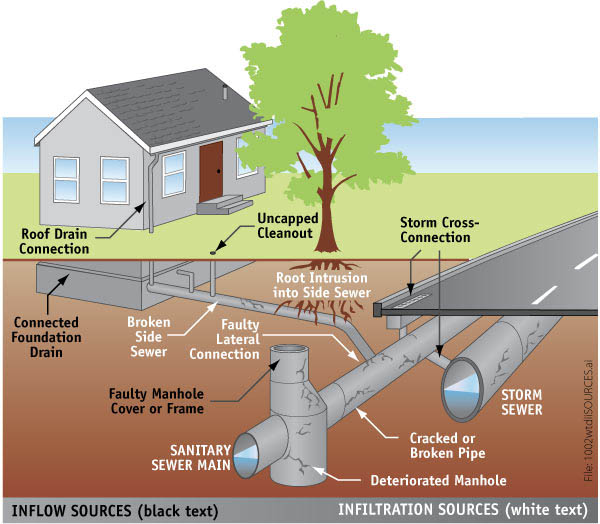Wet Winter Woes: Infiltration and Inflow
Infiltration and inflow (I&I) caused many systems over the winter and through the spring runoff to experience extreme peaks in sewer flows to wastewater reclamation facilities and disposal fields. Rainfall and snow melt can enter wastewater collection systems as inflow, meaning that it comes in through service laterals from items such as sump pumps, downspouts and yard drains or flows in through manhole covers or catch basins. Infiltration, on t he other hand, is caused by the increased precipitation and runoff causing a rise in groundwater level and then the groundwater leaking into the collection system through defective pipes, pipe joints, connections and other subsurface infrastructure such as manholes, wet wells, treatment vaults and equalization basins. Infiltration can occur not just from a rise in groundwater level, but also by way of rainfall entering the collection system via rapid percolation of the soils and shallow infiltration around manholes.
he other hand, is caused by the increased precipitation and runoff causing a rise in groundwater level and then the groundwater leaking into the collection system through defective pipes, pipe joints, connections and other subsurface infrastructure such as manholes, wet wells, treatment vaults and equalization basins. Infiltration can occur not just from a rise in groundwater level, but also by way of rainfall entering the collection system via rapid percolation of the soils and shallow infiltration around manholes.
Although modern construction, inspection and testing of collection system infrastructure significantly reduces I&I in new systems, operators and utilities have to recognize that I&I can be present in any system. Typical wastewater collection system with modern construction materials averages infiltration through gasketed joints of 25 Gal/Day/Inch Diameter/Mile (Uni-Bell Handbook of PVC Pipe). For 8” sewer pipe, that is 38 gallons per day (GPD)/1,000 feet of pipe and for 10” sewer, 47 GPD/1,000 feet of pipe. Older infrastructure with sewer collection systems in disrepair can experience infiltration on the order of five to ten times or more greater than this average.
Inflow is usually reduced through modern construction practices. Through building permit reviews and homeowner education, major reductions in the number of connections from rainfall areas to the collection system can be seen. For inflow through public infrastructure, the major sources are not present in modern sewer collection system design, such as storm sewer catch basins connected to sewer manholes. Also, when manholes are placed in potentially flooded areas, there is an abundance of gasketed manhole cover products on the market to keep that rainwater out.
What to do next? For systems throughout our region which saw major I&I issues throughout the winter and spring, it is best to start addressing the problem with some common sense approaches. Completing visual inspections of the collection system and addressing any known I&I problems first, is the best place to start. Operators often know the unique items in their system which may be the biggest concern for I&I. Next, depending on the size of the system, working with homeowners to educate them on the problems the wastewater system faces with I&I and empower them to work to independently eliminate sources of inflow on their properties.
With the easy problems tackled, wastewater utilities and operators should then look to implement regular inspections of the subsurface infrastructure throughout the system. Today this is accomplished by use of closed circuit television (CCTV) inspection of gravity lines. Video inspection can identify major failures in pipe connections, pipe collapse, poor lateral connections and areas of excessive groundwater entering the system. Utilities should have regular video inspection completed of the entire collection system and these types of inspections are typically required by State discharge permits. Additional emerging technologies for pipe inspection include pipe penetrating radar, light detection and ranging (LIDAR) scanning and sonar. These emerging technologies provide detailed profiles and imagery of pipe condition; they do not have the ability to stop and observe the flows in the pipe as available with video, however multiple images are blended to show flow moving while the sensors travel through the pipe. LIDAR types of pipe scans do provide more details of the pipe, such as roundness and other slight pipe deflections that are sometimes difficult to see with CCTV.
After inspections are completed of the system, utilities and operators must begin the difficult task of allocating resources to address deficiencies. Since these types of repairs are typically shouldered by existing rate payers, finding resources can difficult. System operators must be diligent in bringing these issues to their customers and managing bodies because leaving the problem go for too long can result in fines and orders from the State to address the problems; which is the last place any utility wants to find itself.
Some rainwater gets to the treatment plant … who cares? Modern wastewater reclamation facilities are extremely sensitive biological habitats for good bugs that love to digest our wastewater and turn it into methane gas that can be exhausted and sludge that we can dry and haul to landfills. When excessive amounts of rainwater is sent to our treatment plants, all of these good bugs lose their carbon (food) source and get washed away. When the bugs get washed away, the plant cannot properly treat the regular wastewater flows that come back in high concentration following the storm event or temporary groundwater rise. A wastewater reclamation facility which experiences events like this may be required to divert large flows to emergency holding ponds (if available) or risk violating discharge permit limitations which can result in fines and orders from the State.
As the weather gets warmer, and we slowly forget about the issues that plagued our wastewater systems with high I&I over the winter and spring, be diligent and start addressing the problems now. Just because I&I may not be a problem today, we know it can take just one wet season to turn our collection system world upside down.

